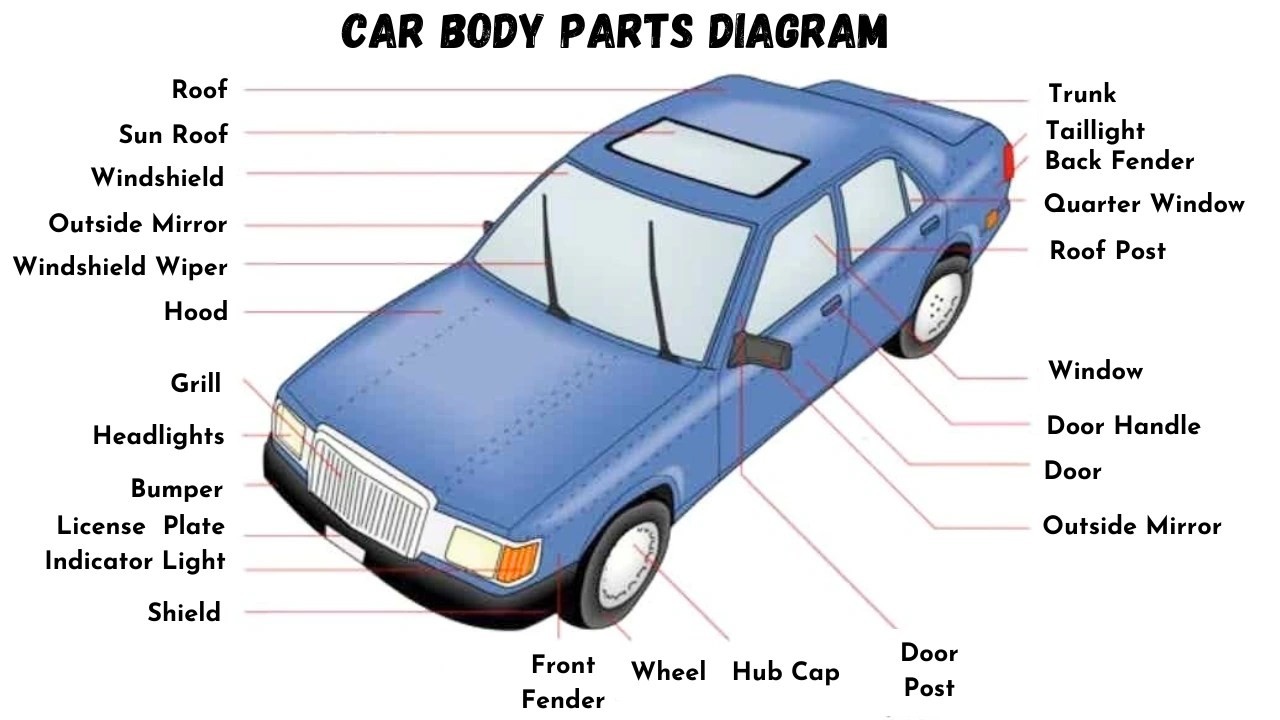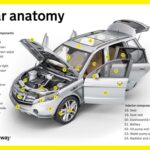Just like the human body has essential parts that enable it to function, a car relies on a complex assembly of components, especially at its front end, to operate correctly and safely. Understanding the names and functions of these car front parts is crucial for car owners, enthusiasts, and anyone involved in vehicle maintenance and repair.
Have you ever wondered about the specific names of the components at the front of your car? This article will guide you through the key Car Front Parts Name, explaining their roles and significance. Whether you’re looking to perform basic maintenance, understand repair needs, or simply expand your automotive knowledge, this guide will provide you with a comprehensive overview.
Exploring the Car Front Body Parts
The front of a car is more than just a face; it’s a carefully engineered structure designed for aerodynamics, safety, and housing critical components. Let’s break down the essential car front parts name and their functions:
- Hood or Bonnet
- Front Bumper
- Bumper Grille
- Headlights
- Fog Lamps
- Indicator Lights (Turn Signals)
- Fenders
- Fender Liners
- Radiator Grille
- Wiper Blades
- Windshield Washer Nozzles
Let’s delve into each of these car front parts name in detail:
#1. Hood/Bonnet
The hood, also known as the bonnet in some regions, is the hinged metal cover that shields the engine compartment at the front of the vehicle. As a prominent car front part, the hood serves several critical purposes:
- Protection: It safeguards the engine, battery, and other vital components from the elements, including rain, snow, debris, and extreme temperatures.
- Access: The hood provides easy and safe access to the engine bay for routine maintenance, fluid checks, and repairs.
- Safety: In a frontal collision, the hood is designed to crumple and absorb some of the impact energy, helping to protect occupants.
- Aerodynamics: The shape and design of the hood contribute to the car’s overall aerodynamic profile, reducing drag and improving fuel efficiency.
Modern car hoods are typically constructed from steel or aluminum for strength and weight considerations. Some high-performance or aftermarket hoods may utilize lighter materials like carbon fiber or fiberglass. A secure latching mechanism keeps the hood firmly closed during driving, usually released from inside the car.
#2. Front Bumper
The front bumper is a crucial safety car front part designed to absorb impact in low-speed collisions. Positioned at the very front of the vehicle, the bumper extends across the width of the car and often wraps around the front corners, partially covering the wheel arches. Its main functions include:
- Impact Absorption: The primary role of the front bumper is to minimize damage to the vehicle’s body and components in minor front-end collisions, protecting more vulnerable parts like the headlights, grille, and radiator.
- Pedestrian Safety: Modern bumper designs also consider pedestrian safety, incorporating energy-absorbing materials and shapes to reduce injury in the event of a pedestrian collision.
- Aesthetics: Bumpers are integral to the car’s styling and contribute to its overall visual appeal. They are often designed to integrate seamlessly with the car’s lines and features.
- Mounting Point: The bumper provides a mounting point for other car front parts such as fog lights, parking sensors, and the front license plate.
Bumpers are typically constructed from plastic, steel, aluminum, or composite materials, engineered to balance impact resistance with weight and styling considerations.
#3. Bumper Grille
Located within or just above the front bumper, the bumper grille is an often stylish and functional car front part. It’s typically designed with an open mesh or slat pattern and serves several important purposes:
- Airflow: The primary function of the grille is to allow air to flow into the engine compartment. This airflow is critical for cooling the engine, radiator, and other components, preventing overheating.
- Protection: While allowing airflow, the grille also acts as a barrier, preventing larger debris like stones, leaves, and road debris from entering the engine bay and potentially damaging sensitive components.
- Styling: Grilles are a significant design element and are often unique to each car make and model. They contribute significantly to the car’s front-end appearance and brand identity.
- Aerodynamics: The design of the grille can also influence the car’s aerodynamics, directing airflow for cooling and minimizing drag.
Car grilles come in various styles, including mesh grilles, slat grilles, and even active grilles that can open and close to optimize airflow and aerodynamics based on driving conditions.
#4. Headlights
Headlights are essential safety car front parts mounted at the front of the vehicle, providing illumination for driving in low-light conditions and at night. They are critical for visibility and safe driving, and their functions include:
- Illumination: Headlights produce a powerful beam of light that illuminates the road ahead, allowing the driver to see obstacles, road markings, and other vehicles clearly in the dark.
- Visibility to Others: Headlights make the vehicle visible to other drivers, pedestrians, and cyclists, especially at night and in poor visibility conditions, helping to prevent accidents.
- Signaling: Headlights are often integrated with daytime running lights (DRLs) which increase vehicle visibility during daylight hours. They also work in conjunction with high beam and low beam settings for different driving situations.
- Safety Regulations: Headlight design and performance are strictly regulated to ensure adequate illumination and prevent glare for oncoming drivers.
Modern headlights utilize various technologies, including halogen, LED, and xenon bulbs, each offering different levels of brightness, energy efficiency, and lifespan. Headlight designs are constantly evolving with advancements in automotive lighting technology.
#5. Fog Lamps
Fog lamps, or fog lights, are specialized car front parts designed to improve visibility in adverse weather conditions like fog, heavy rain, or snow. They are typically mounted lower than the headlights and produce a wide, low beam of light. Their key functions are:
- Improved Visibility in Fog: Fog lamps are designed to cut through fog by aiming a wide, flat beam of light low to the ground, reducing glare and illuminating the road edge and lane markings.
- Visibility in Other Poor Conditions: They are also effective in heavy rain, snow, and dust, improving the driver’s ability to see the road and be seen by other drivers.
- Complementary to Headlights: Fog lamps are intended to be used in conjunction with low beam headlights in foggy conditions. They are not a substitute for headlights in normal driving conditions.
- Safety Enhancement: By improving visibility in challenging weather, fog lamps significantly enhance driving safety, reducing the risk of accidents.
Fog lamps often have a distinctive yellow or white light and are designed to be used at lower speeds due to their wide beam pattern.
#6. Indicator Lights (Turn Signals)
Indicator lights, also known as turn signals or blinkers, are crucial communication car front parts located at the front corners of the vehicle. They are designed to signal the driver’s intention to turn or change lanes. Their primary function is:
- Signaling Turns: When activated, indicator lights blink on the side of the intended turn, alerting other drivers, pedestrians, and cyclists of the vehicle’s upcoming maneuver.
- Lane Changes: They are also used to signal lane changes on highways and multi-lane roads, ensuring safe merging and maneuvering.
- Hazard Warning: When all indicator lights are activated simultaneously, they function as hazard warning lights, indicating a potential hazard or emergency situation.
- Safety Communication: Indicator lights are a vital part of road safety, enabling drivers to communicate their intentions clearly and predictably, preventing accidents and promoting smooth traffic flow.
Indicator lights are typically amber in color and are designed to be highly visible in both day and night conditions.
#7. Fenders
Fenders are curved car front parts that frame the wheel wells at the front of the vehicle. They are essential for both functionality and aesthetics, serving several purposes:
- Protection from Road Debris: Fenders prevent mud, water, stones, and other road spray from being thrown up by the rotating tires and hitting the car’s body, windshield, or other vehicles.
- Wheel Well Coverage: They enclose the wheel wells, providing a clean and finished look to the car’s exterior.
- Aerodynamics: Fenders can be shaped to improve airflow around the wheels, contributing to the car’s overall aerodynamic efficiency.
- Styling: Fenders are a significant design element, influencing the car’s stance and appearance. They can be flared, sculpted, or integrated into the body lines to create different visual effects.
Fenders are typically made of steel, aluminum, or plastic and are designed to be durable and resistant to corrosion and impact.
#8. Fender Liners
Fender liners, also known as wheel well liners or inner fenders, are plastic or composite car front parts that fit inside the wheel wells, behind the fenders. They provide an additional layer of protection and serve several important functions:
- Protection from Corrosion: Fender liners shield the metal wheel wells from moisture, salt, road debris, and chemicals, preventing rust and corrosion.
- Noise Reduction: They can help dampen road noise and vibrations, improving cabin comfort.
- Protection of Components: Fender liners protect sensitive components located within the wheel well, such as wiring harnesses, brake lines, and suspension parts, from damage caused by road debris and water.
- Easy Cleaning: They create a smooth, easy-to-clean surface within the wheel well, preventing mud and debris buildup.
Fender liners are designed to be durable and flexible, able to withstand impacts and harsh environmental conditions.
#9. Radiator Grille
While sometimes used interchangeably with “bumper grille,” the radiator grille specifically refers to the grille located directly in front of the radiator, often situated higher up on the front fascia. It’s a critical car front part for engine cooling. Its primary functions are:
- Direct Airflow to Radiator: The radiator grille’s main purpose is to allow maximum airflow to the radiator, which is responsible for cooling the engine coolant. This airflow is essential to prevent engine overheating.
- Protection of Radiator: It also provides a degree of protection to the radiator from larger debris, although its primary function is airflow.
- Styling Element: Like the bumper grille, the radiator grille is a significant styling element, contributing to the car’s front-end design and brand identity.
The design and size of the radiator grille are carefully engineered to provide optimal cooling for the engine while also considering aerodynamic and styling requirements.
#10. Wiper Blades and Windshield Washer Nozzles
While technically not body parts in the same way as panels, wiper blades and windshield washer nozzles are critical car front parts for visibility and safety.
- Wiper Blades: These rubber blades, attached to wiper arms, sweep across the windshield to remove rain, snow, dirt, and debris, ensuring a clear view of the road ahead. They are essential for safe driving in inclement weather.
- Windshield Washer Nozzles: These small nozzles spray windshield washer fluid onto the windshield. This fluid, combined with the wiper blades, effectively cleans the windshield of stubborn dirt, bugs, and grime, further enhancing visibility.
Together, wiper blades and windshield washer nozzles are indispensable for maintaining clear visibility and safe driving in all weather conditions.
Conclusion: Understanding Your Car Front
Knowing the car front parts name and their functions empowers you to better understand your vehicle, perform basic maintenance, and communicate effectively with mechanics. The front of your car is a complex and carefully designed area, integrating safety, performance, and aesthetics. By familiarizing yourself with these key components, you’ll gain a deeper appreciation for automotive engineering and be better equipped to care for your vehicle.

